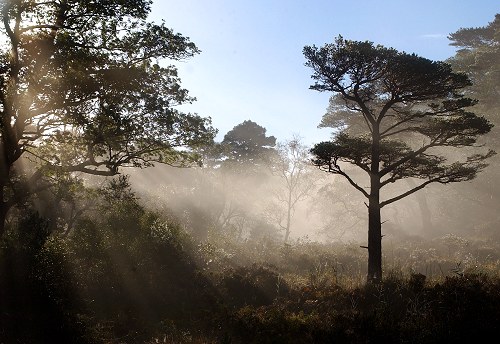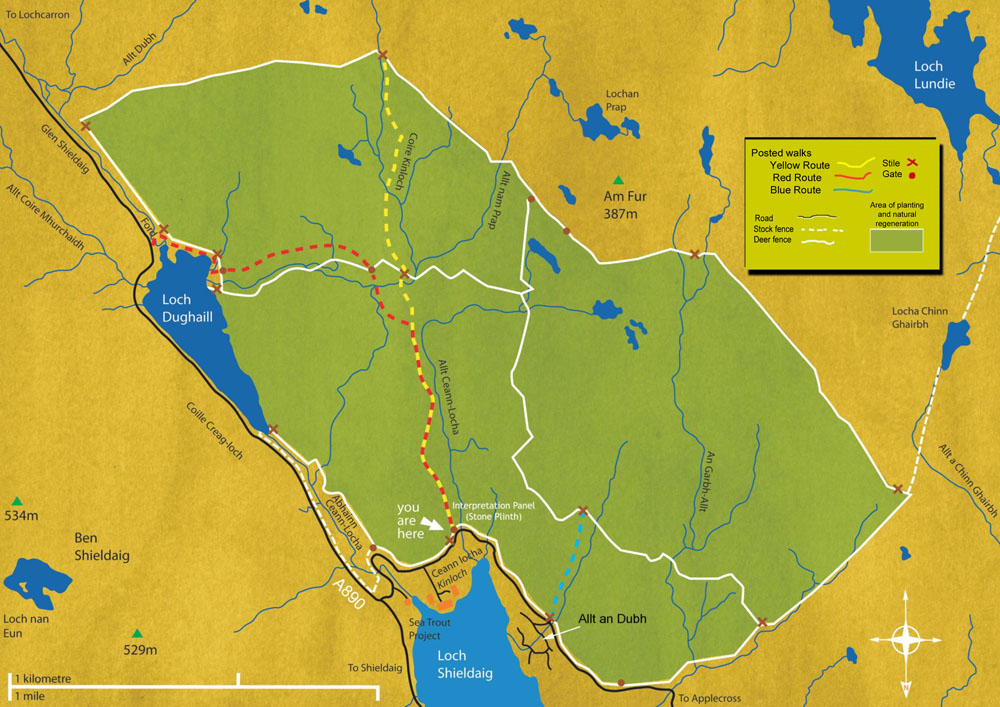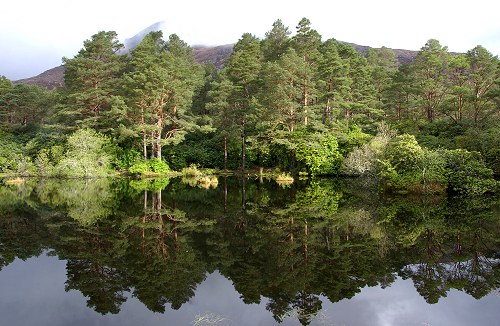
This page is available in Gaelic ~ link here 
Woodland
around Torridon & Shieldaig
The
woodland landscape is changing significantly over the whole area,
from North Applecross to Shieldaig, east through Glen Torridon and
south to Lochcarron.
The
beauty of the highest hills remain. But on lower ground, the scattered
remnants of the once great, ancient Caledonian pine forest are few
and far between. The most attractive areas of native woodland are
probably those on Beinn Eighe, at Coulin, on Ben Damph and on the
west side of Ben Shieldaig. However, in between these woodland areas
there are considerable areas of of over-grazed, tussocky heather and
sedge.

The
most noticeable feature over the past ten years has been the increase
in the amount of deer fencing. This is apparently only a temporary
necessity. New birch trees have been planted, as have many young Caledonian
pines. Once the struggling saplings have grown, the fences can be
removed.
In
the triangle from Applecross to Kinlochewe to Lochcarron, 3,600 acres
of land so far have been fenced off to be returned to native woodlands.
Where mature trees and seed sources have survived and wherever conditions
will allow it, the new woodlands will will be established by natural
regeneration. If this cannot be possible, then saplings have been
raised in tree nurseries using local seed sources and planted in a
natural way. So far, one and a half million trees have been planted.
Approximately a half of these are Caledonian pine; also there are
Downy Birch, Rowan, Willow, Alder, Aspen, Gean, Sessile Oak and Holly.
Funding for the projects has come through the Woodland Grant Scheme
(Forestry Commission), the Farm Woodland Premium Scheme (SEERAD) and
the National Lottery.


Kinloch Woodlands – information booklet draft
Most of us are familiar with the story of how over the centuries the Scottish Highlands has lost its native woodland cover, to the point where only a few remnants of the ancient Caledonian forest now remain. Climate change has played a part but most of the damage has been done by man. In more recent times the two most significant factors have been the large scale introduction of sheep in the late 1700’s and early 1800’s and the Victorian passion for sporting estates, leading to a big increase in the numbers of wild red deer. Swathes of the West Highlands in particular have been turned into what that eminent 20 century biologist Frank Fraser Darling described so accurately as a “wet desert”, with eroded soils, few trees, a badly degraded habitat and very little wildlife.
That’s the bad news. The good news is that over the last 25 years the Scottish Government and its predecessors have been encouraging landowners to do something about it. Shieldaig is particularly significant because of the remnant of ancient woodland established after the last ice age which remains on the north and west slopes of Ben Shieldaig. The decision was taken in 1994 to try to extend this woodland to the west in a similar form and with the same tree species, so that in time a natural woodland might be re-established along the coastal slopes of the North Applecross peninsular.
The Kinloch Woodlands SCIO [Scottish Charitable Incorporated Organisation] owns and is responsible for the 3500 acres of hill land between the Shieldaig/ Lochcarron road and the Inverbain river extending as far south as Loch Lundie.
Woodland restoration work was started in 1994 and a total of 1000acres of land have now been fenced to exclude deer and sheep. A few mature trees were left and in these areas the new woodland is being established by natural regeneration. However over most of the ground, it has been necessary to plant native saplings. This has been done by hand in a manner designed to look as natural as possible with a mix of thickets and open areas. Over 200,000 Caledonian/ Scots pine saplings have been planted, grown from seeds taken from cones gathered on Ben Shieldaig together with some 300,000 downy birch, rowan, alder, willow, hazel, sessile oak and wild cherry.
If you walk through the lower fenced area above Kinloch, you will get a feel for what the fully restored woodland should look like as it matures. Clumps of pines on the heather mounds and the better drained areas, birch on some of the lower slopes and along the banks of the burns, and rowan being spread by the birds all over the place.
The saplings in the upper fenced area are doing well but because the ground is more exposed and the planting was done 5 years later in 1999, the young trees are coming on at a slower rate.
As the habitat improves, the wildlife is starting to return. Butterflies and dragonflies are now much more common and we are seeing more smaller birds such as meadow pipits, coal-tits, wrens and siskins. Buzzards are now relatively abundant and the white tailed eagles which have settled in the Shieldaig area are often seen on the hill, particularly if there is a deer carcase to be had. Hopefully by the time this article is published, red squirrels will have been reintroduced in the established woodland on the western slopes of Ben Shieldaig and over time they will extend their range to the emerging woodland further west [cross reference to squirrel article].
Management responsibility for the estate now rests with the Kinloch Woodlands SCIO which took over from the Kinloch Woodlands Charitable Trust in November 2015. It is a partnership between the Munday family and the Shieldaig community with 9 trustees; 4 family, 3 community and 2 professional. Its charitable aims are essentially to improve the natural environment of the area with a particular focus on recreational and other benefits for the local community. There is also a close working relationship with Marine Scotland who are undertaking research work on sea-trout from their base at the mouth of the Shieldaig river.
Continuing and sustainable improvement of the woodlands will be the key feature and we hope that in the medium term the birch woodlands in particular will offer scope for small scale fire-wood production for a local market. Effective deer management will remain essential, particularly once the fences are removed and this may offer scope for some local jobs in selling venison.
The successful “run of river” hydro-electric scheme at Inverbain, which has been operated by RWE Npower for over 10 years, is a good example of how income can be generated for local benefit without any significant detriment to the environment.
We hope that as the woodland improves, more people will be encouraged to walk up into the area and see for themselves how things are changing. There is probably also scope for more interpretation work particularly for local schools and visitors. And if you have any thoughts about new initiatives, the trustees would be very happy to hear about them.
The Kinloch Woodlands SCIO : Contact – 01520 755 206.

What
will emerge in the future will be woodlands with mixed open structures
rather than dense impenetrable forests. Dense pockets of Pine with
Birch, Rowan and Sessile Oak will be established on the better drained
knolls, ridges and heather slopes; Birch, Alder, Willow and Holly
will be growing up the sides of the burns and there will be open spaces
in between. As the plans develop, the new woodland areas will link
up with each other to provide continuity in the landscape and corridors
of movement for wildlife.
What
will also follow will be more birds as the winter shelter and natural
cover improves. Once the area of new pine forest is established, it
is hoped to re-introduce the Red Squirrel. There will also be opportunities
to make new woodland walks. As soon as the new native trees are established,
the deer fences and cattle grids can be removed.
Back




